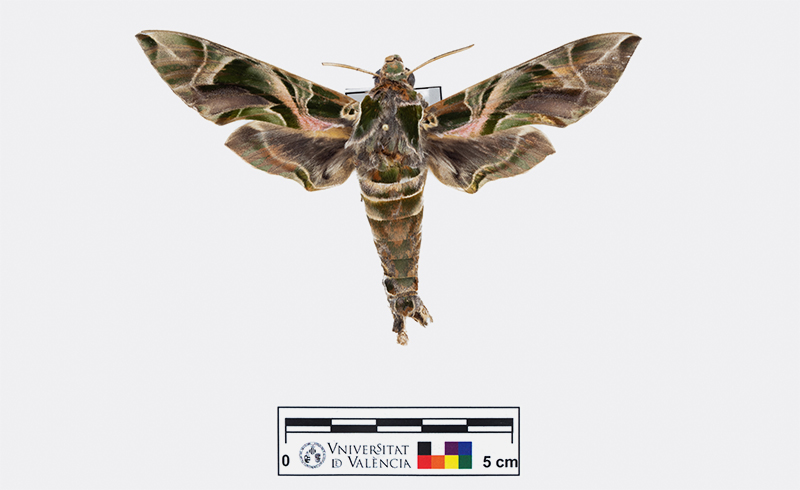Female Oleander Sphinx (Daphnis nerii (Linnaeus, 1758)). Entomology Collection of the University of Valencia. Code: ENV00030688.
Sphingids are nocturnal butterflies that reach important sizes. They are large fliers, characterized by the lengthening of the forewings and the smaller relative size of the posterior ones. In Spain, there are about twenty species.
The Daphnis genus is represented by nine species of tropical or subtropical distribution in the Old World. But only one of them, Daphnis nerii (Linnaeus, 1758), reaches Europe exceptionally, due to migratory movements. The natural habitats of this species are found in Africa and tropical Asia, from where every year, a variable number of specimens, move north in their migratory movements. In general, they reach Europe, and dispersed and scarced sepcimens can be observerd anually in the continent. They can’t return to their original areas and they die during the flight, but they often leave offspring during their journey. Females lay their eggs on Nerium oleander and Vinca spp. leaves and flowers, and caterpillars feed on them. They are spectacular, large sized, and green coloured butterflies with two blue spots on the anterior side of the body that imitates vertebrate eyes and are supposed to be useful as a defense against birds and other predators.
At the beginning of 2019, Pepe Greño, a collaborator of our institution, sent us a specimen of this species that was located on one of the roads from the Alicante airport to “El Altet” (a town of “Elche”). It was a female who had been run over and was on the pavement. Despite its condition, we were able to recover and prepare it, following the appropriate protocol. The specimen is already cataloged in the Univeristy of Valencia Entomology collections.
As can be seen, the attractiveness of the adult is remarkable, with intense green and pink colors and a wing span of between 90 and 110 mm. It is a very characteristic and easily recognizable species. From MUVHN, we encourage our followers to report the presence of this species, if they observe it.


















